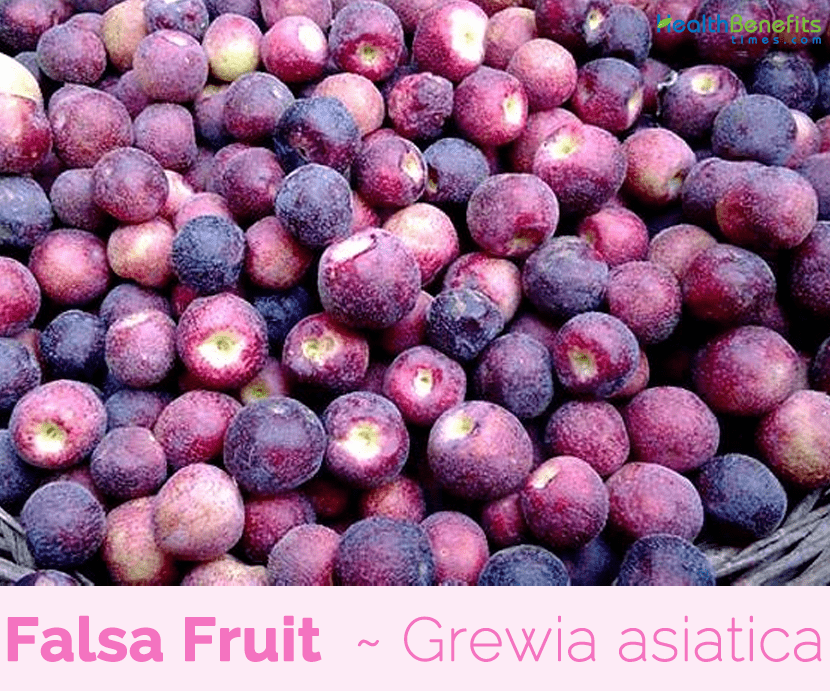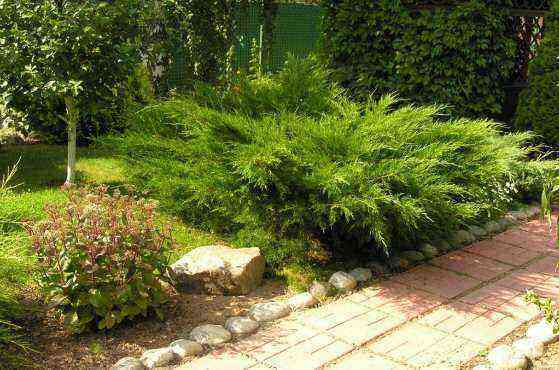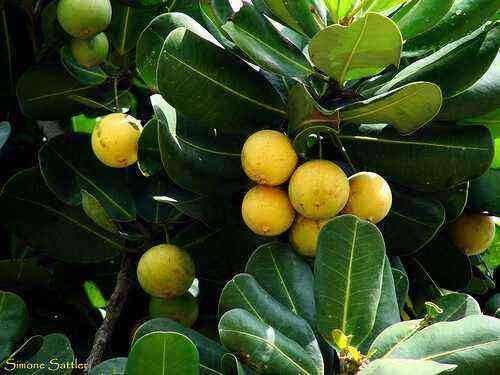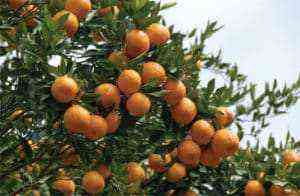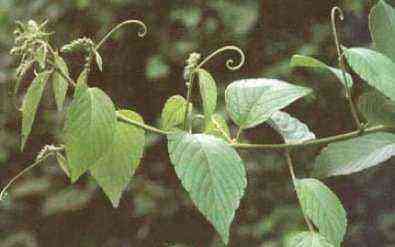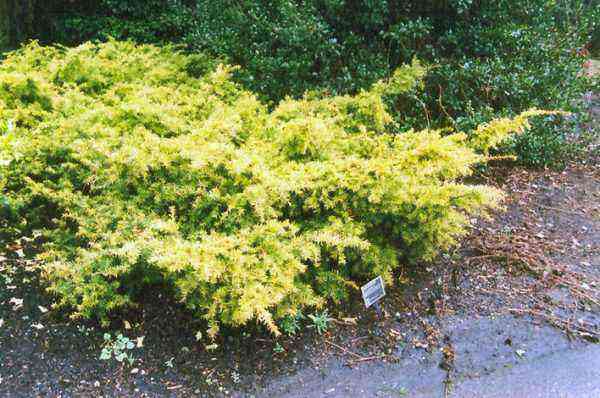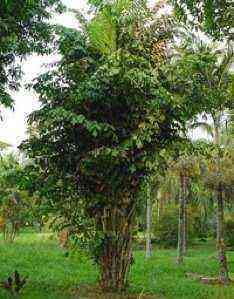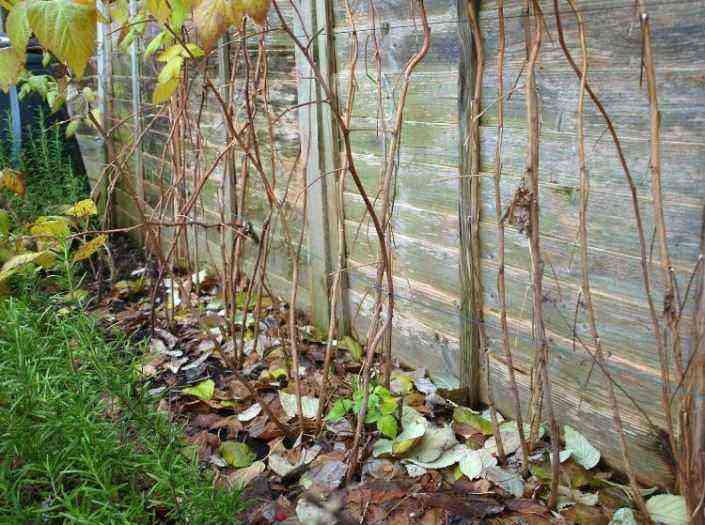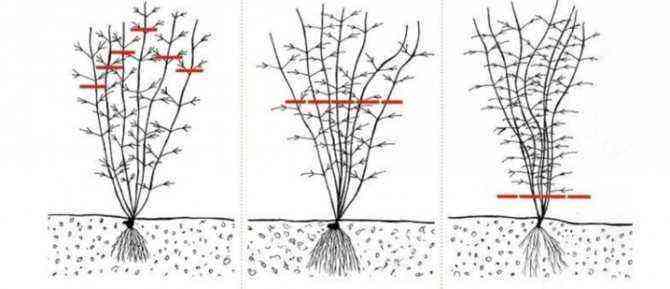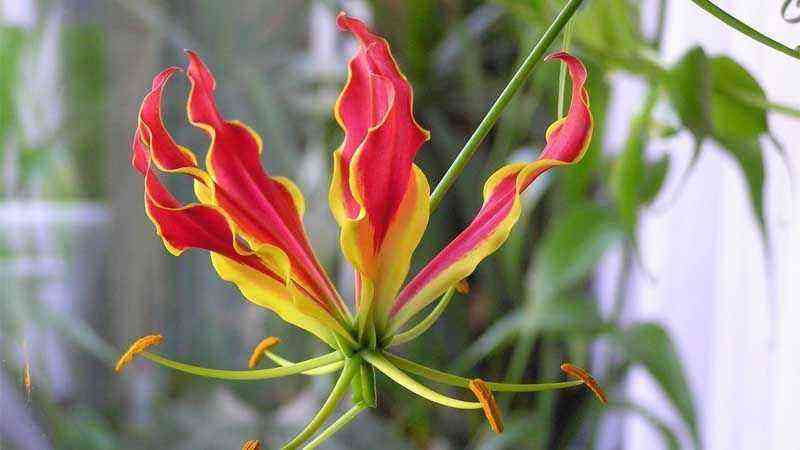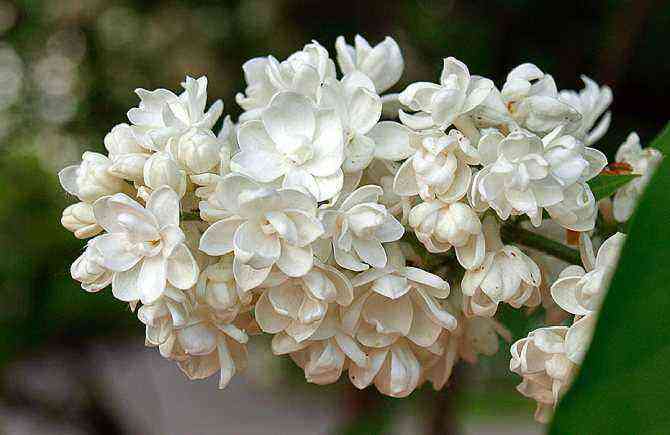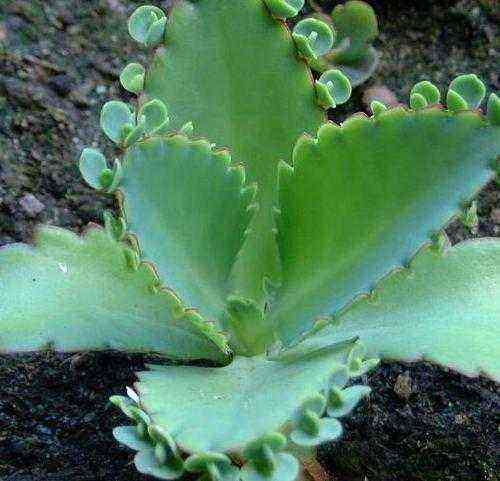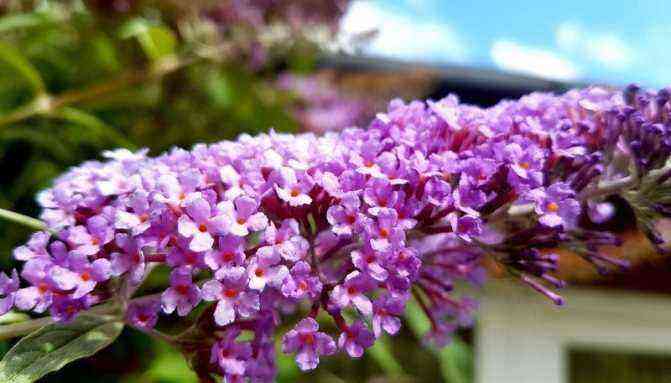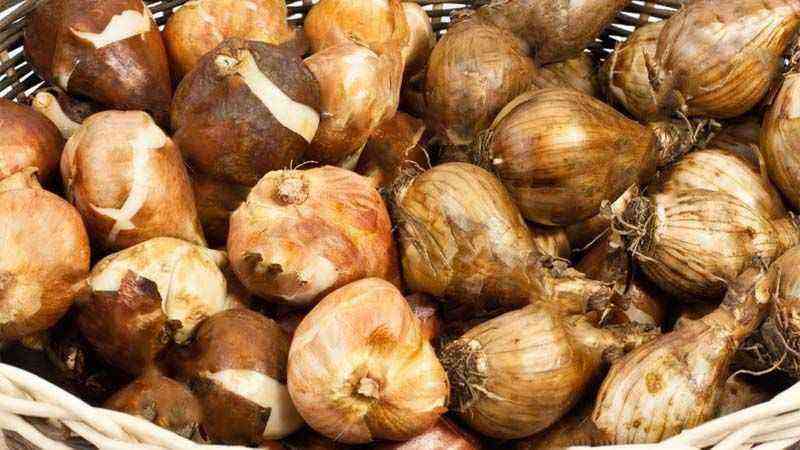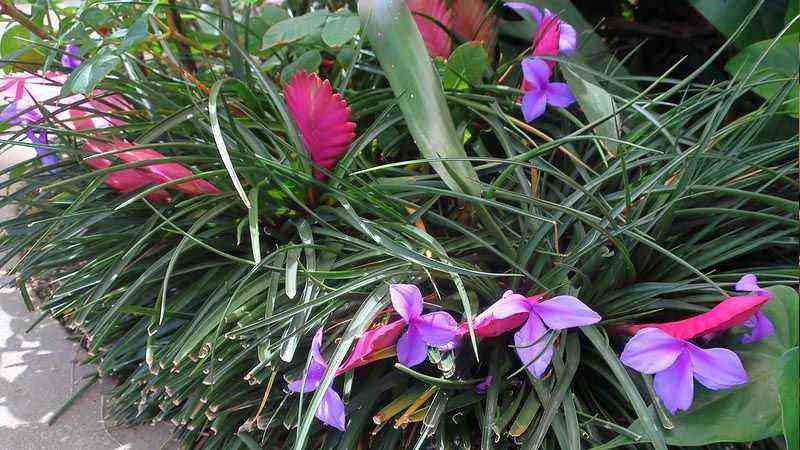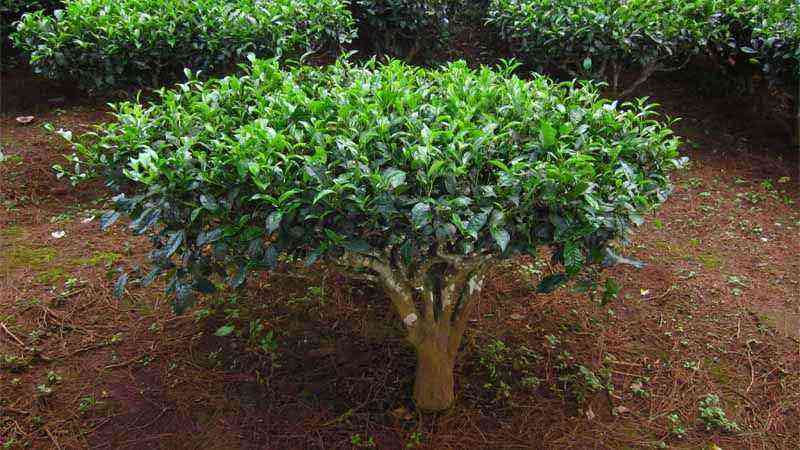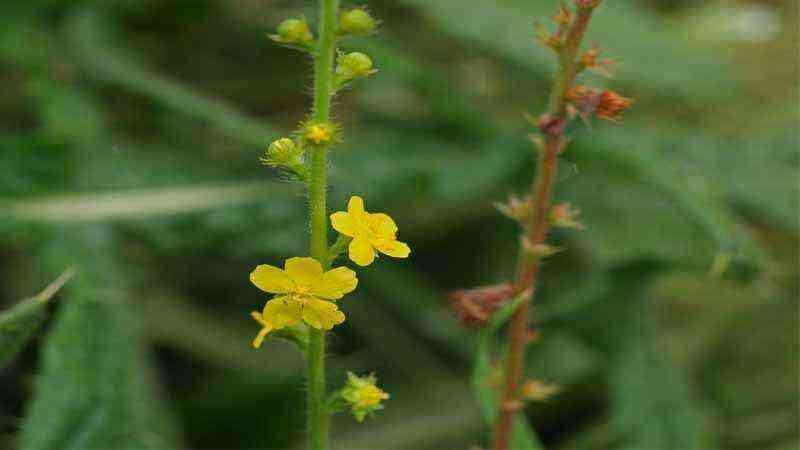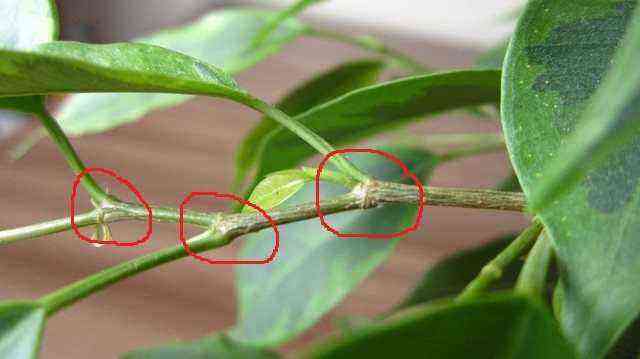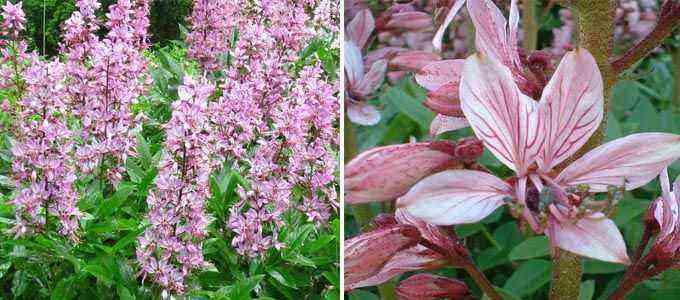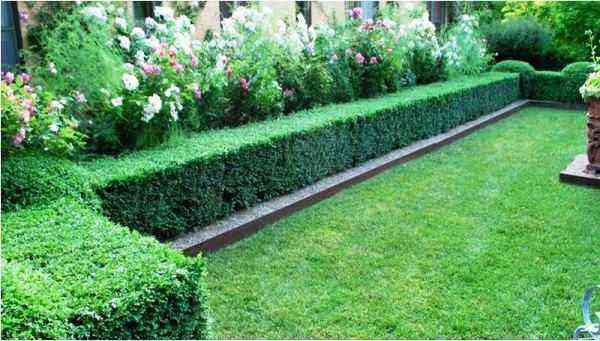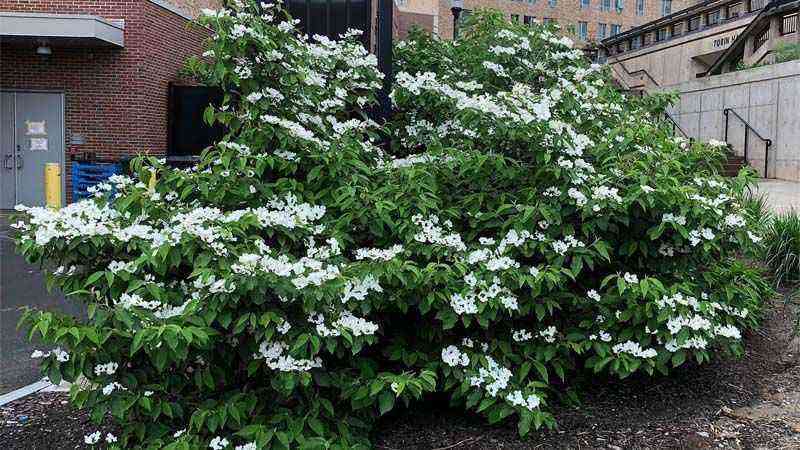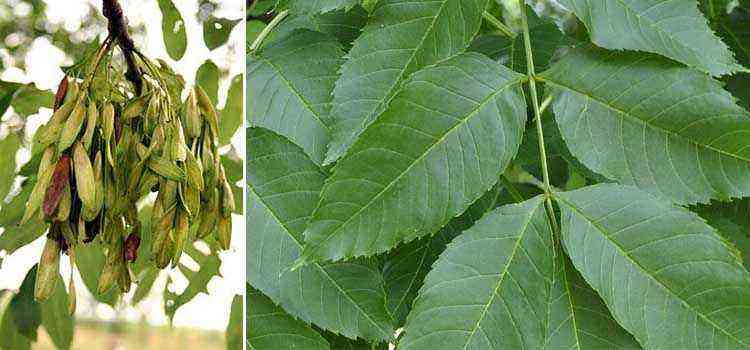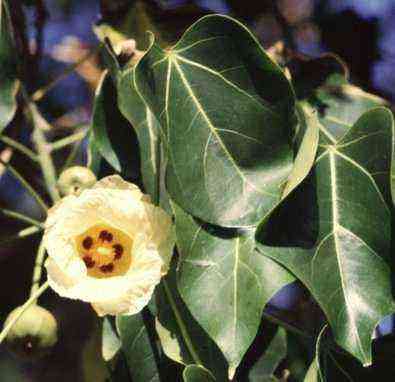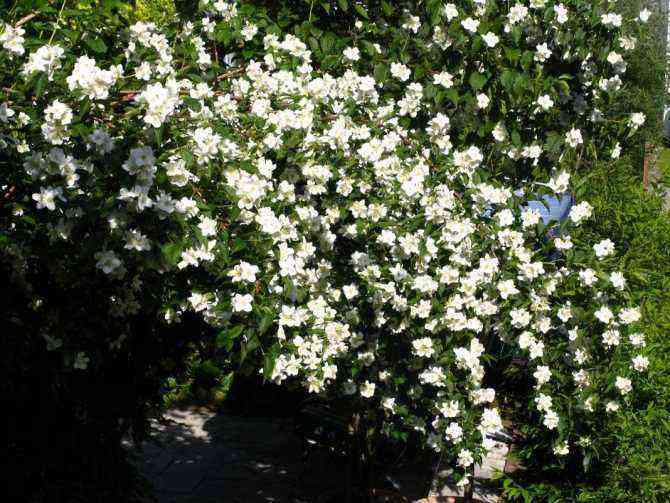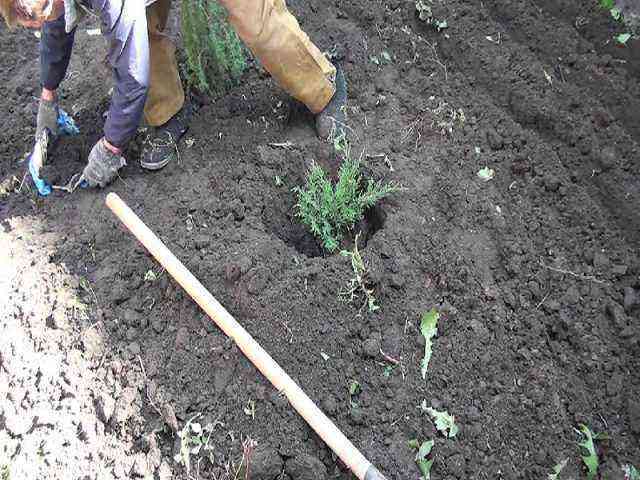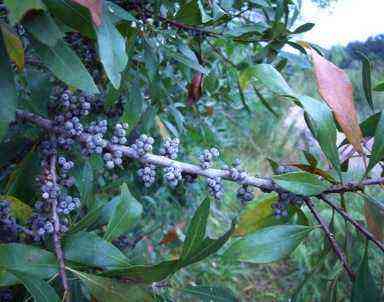Clematis is a favorite flower of landscape designers. A popular plant among amateur gardeners. Among the popular varieties of its magnificent forms, Clematis is a large-flowered privateer Rouge Cardinal, a description of which we will now consider.
Clematis hybrid Rouge Cardinal was bred by French breeders. Decorative climbing liana with large flowers grows up to 3 m in height. The color of young shoots is light green. Leaves of medium size, complex trifoliate. The color of the leaf blade is dark green. One vine leaf consists of several small leaves. The front surface of the leaf blade is leathery.
Important! A feature of the Rouge Cardinal variety clematis is its rapid growth. Vine shoots can stretch more than 10 cm in length per day.
The root of clematis is powerful, goes deep into the ground. Flowers appear on new shoots. The flowering period is considered late and lasts from early July to September. The liana is densely covered with velvety large flowers with dark purple petals. The shape of the inflorescences is cruciform. In diameter, a blossoming flower can reach 15 cm.
Liana of the Cardinal variety is very tenacious. The plant grabs onto any object, fixes itself and continues to stretch further upward. If the clematis lash caught on a tree, then during the season it will completely surround it.
Considering clematis Rouge Cardinal, description, photo, reviews, it is worth noting that the plant is not capricious to care. The variety is rarely affected by pests and pathogens. Liana endures cold winters.
Attention! At an exhibition in Holland, Rouge Cardinal was awarded a gold medal.
Features of growing vines
Any garden plant, even if it is unpretentious, requires adherence to the rules of care. Continuing the review of Clematis Rouge Cardinal, photo and description of the variety, it is worthwhile to familiarize yourself in detail with the conditions of agricultural cultivation.
Seed sowing
To grow Clematis Rouge Cardinal from seedlings, you need to visit a flower shop. The plant can be sold in a plastic pot with or without fertilized substrate. A bare root seedling is not the best option. It is optimal to grow a flower from seed, which is what most gardeners do.
If a decision is made at home to grow clematis large-flowered privateer Rouge Cardinal, first prepare the site. A hole with a depth and diameter of 60 cm is dug under one flower. A 15 cm thick drainage layer of small stones or broken brick is poured onto the bottom. Half of the remaining volume of the hole is filled with humus. Any rotted manure or leaf compost will do. The rest of the free volume of the hole is filled with fertile soil. The pit is prepared at least a month before planting. During this time, the earth will settle, beneficial microorganisms will start, and earthworms will mix humus with the soil.
Sowing dates for the Cardinal are determined by gardeners by the size of the seeds. Large grains are strong. Seeds are sown in late autumn before winter. For the reliability of obtaining seedlings, grains can be stratified within three months at a temperature of + 5 ° C and sown in spring.

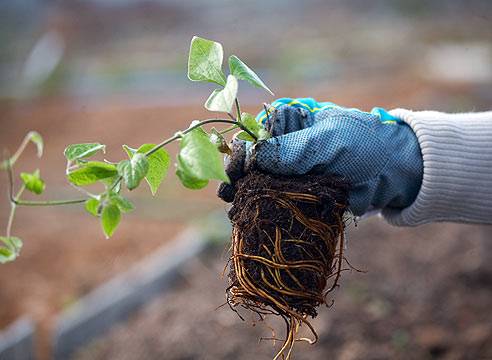
Small grains in the ground may not overwinter. Such seeds are sown only in spring. The best months are March and April. Sow the Cardinal’s seeds in open ground or set up a small greenhouse to accelerate germination.
Important! The seeds of the Cardinal variety are characterized by a low germination rate and long germination. Because of this feature, gardeners often prefer ready-made seedlings.
Before planting seedlings grown from seeds or purchased, a trellis is installed near the prepared holes. The height of the supports above the ground is made at least 2 m.If the liana grows near the house, then the planting hole should be at least 20 cm away from the wall.The trellis is placed at a distance of 10 cm from the hole.
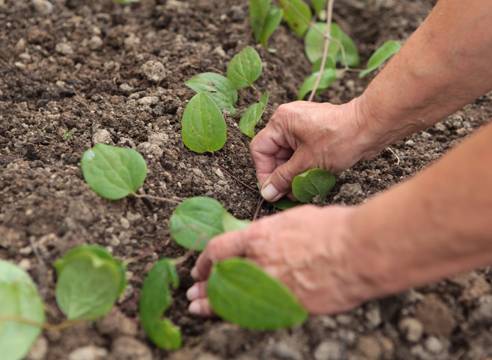

If a seedling of the Cardinal variety is grown from seeds in a glass, then planting in a permanent place is carried out according to the following rules:
- They begin to prepare the seedling for planting by examining the roots. If for some reason the root system is dry, it is soaked in cold water.
- Part of the fertile soil is taken out of the previously prepared hole. At the bottom, a mound is formed from the soil, lightly tamping it with your hands.
- A seedling is placed on a hill. The root system is straightened along the slopes of the mound. If a seedling is removed from a glass with a whole lump of earth, then in this state it is placed on the bottom of the hole.
- Backfilling of the root system is performed with fertile soil extracted from the hole. Moreover, the root collar and part of the stem of the seedling are covered.
- At the end of planting, the plant is watered abundantly with water at room temperature.
When several clematis are planted next to each other, a minimum distance of 1,5 m is maintained between the seedlings. During the summer season, the growth of vines is monitored. If clematis large-flowered Rouge Cardinal is depressed, gives a small increase, then the place is not suitable for the plant. The problem can be solved only by transplanting the vine next spring to another site.
Rules for planting clematis varieties of roses cardinal
Flowers of this variety are quite unpretentious and will grow well even in a shaded place. If you want to run clematis on a support of a certain shape, then it would be better to choose a quiet, windless place, since with a constant strong wind, the vine can begin to grow unevenly.
Clematis takes root well on almost all types of soil, except for peaty, clayey and very acidic ones. But if you improve its structure, then planting a plant is possible on such soils. You can prepare the soil for planting as follows:
- into peaty soil, introduce garden soil and sand in equal parts;
- for clay soil, you need to take leafy soil, sand and peat in equal parts;
- acidic soil can be neutralized with lime at the rate of 300 g per 1m².
It is better to plant the Cardinal Rouge variety in the spring, in April or May, so that it takes root well and gets stronger over the summer.


Clematis rouge cardinal is planted in April-May
Advice. If you purchased clematis seedlings in containers, then they can be planted at any time.
The planting of these flowers must be carried out in several stages:
- Prepare a pit about 50 cm wide and deep and fill it with humus, superphosphate (200 g), wood ash (150-200 g) and dolomite flour (150 g).
- Dig a trench to drain excess moisture at a distance of 10-15 cm from the pit.
- Inspect the seedlings and remove damaged roots, treat the cut site with a manganese solution. On the aerial part of the shoot, you need to cut off all the shoots above the first bud.
- Pour a little enriched soil into the center of the prepared hole, place a seedling on top, having previously straightened all the roots.
- It is necessary to deepen the seedling to the root collar and sprinkle with a moist nutrient mixture.
- It is necessary to install supports during planting, the diameter of the support is not more than 2 cm.

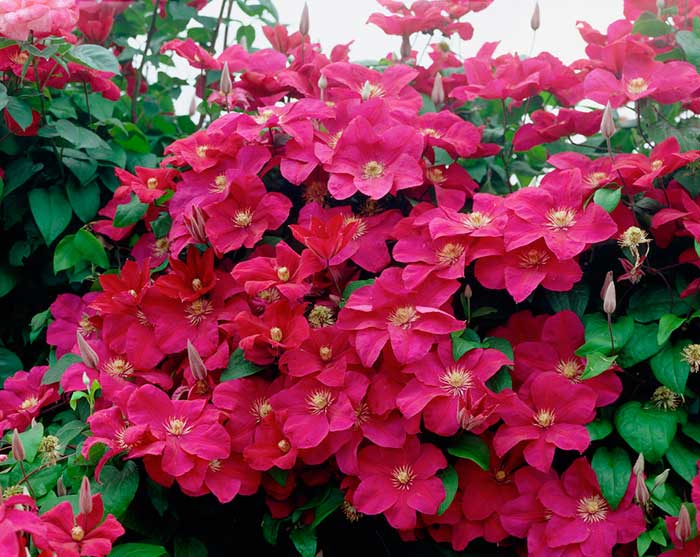
Clematis rouge cardinal does not require special care
Features of caring for a vine
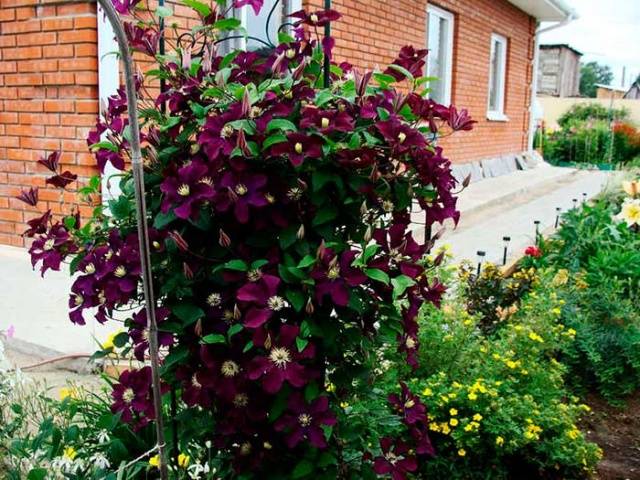
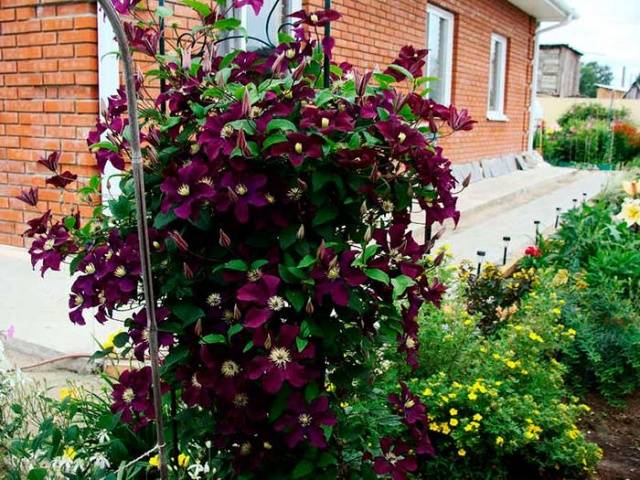
For the gardener, planting clematis Rouge Cardinal and caring for the plant will not cause much trouble. Liana is watered, and quite often. Clematis is very fond of moisture. Since the root system grows far into the depths of the earth, a lot of water is poured under the plant. After watering, the soil is loosened. Weeds are periodically weeded.
Clematis of the Cardinal variety love frequent feeding. For the splendor of flowers and the formation of a large number of new inflorescences, fertilizers are applied twice a month. The type of feeding liana depends on the season:
- When shoots begin to grow on clematis in spring, the liana needs nitrogen. The flower is fed with ammonium nitrate. From organic matter, a solution of bird droppings or mullein is used.
- With the onset of the appearance of buds, organic matter is combined with mineral complexes.
- In summer, during flowering, Clematis of the Cardinal variety is watered with a pink solution of manganese. A weak boric acid solution can be diluted.
- By the end of August, shoots should begin to ripen on clematis. To speed up the process, the vine is fed with stimulating mineral complexes. Fertilizing from wood ash helps to ripen the flower shoots faster.
- In the fall, before preparing for wintering, the soil under the clematis is dug up with the introduction of potassium sulfate.
All types of flower dressings are usually introduced simultaneously with abundant watering so that beneficial trace elements can penetrate deep into the ground to the root system.
Methods of reproduction
The hybrid is easy to propagate in several ways. Each has features and secrets on which the success of the procedure depends. The procedure is best done in the spring when the plant is actively growing.
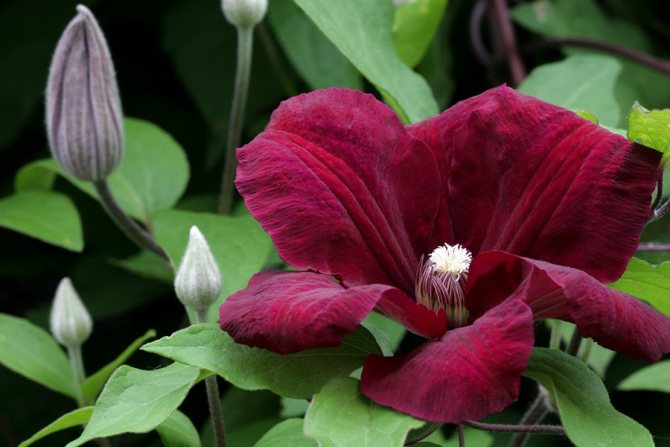

Clematis red cardinal
Division of the bush
Old thickened bushes begin to bloom worse, get sick and die earlier if they are not rejuvenated. Dividing a bush is both reproduction and rejuvenation of the plant. At the same time, the bush is dug up, the earth is shaken off from the roots and separated with a sharp knife. Slices are sprinkled with activated carbon.
Separated bushes are placed in pre-prepared pits. The distance between them must be at least one meter. Landing is needed according to all the rules, with the placement of supports in the landing pit. At first, the seedlings are watered often – every 2 days. By the end of the season, when they have taken root, watering can be reduced.
Layers
A very simple and reliable breeding method. One of the lianas is pulled to the side and bent to the ground. All that remains for the gardener to do is to dig it into the ground, leaving the top on the surface. With regular watering, the cuttings take root in a month, and by the end of the season it is already an independent young plant.
However, it is better to separate the layers from the mother bush next year. It will be easier for him to overwinter in conjunction with the main adult plant. In the spring, when clematis grows, the layers can be separated and transplanted to a new permanent place.
Cutting
It is better to cut the cuttings in the spring, when the sap flow has already begun. One vine can be divided into 3-4 cuttings, 3-4 buds each. They can be rooted in water or soil. The second option is preferable, so the plant does not experience unnecessary stress during transplantation.
A special rooting substrate is prepared – light and loose, as breathable as possible. Its composition is as follows:
- garden land;
- perlite;
- vermiculite;
- Styrofoam;
- coarse sand.
In such a substrate at a temperature of +27 ° C, the cutting will take root in 2-3 weeks. As soon as new young leaves appear, the seedling is ready for transplanting into the ground. For the first year, it is better to place it in a greenhouse on the site, and then, after winter, plant it in a permanent open place.
Trimming for the winter

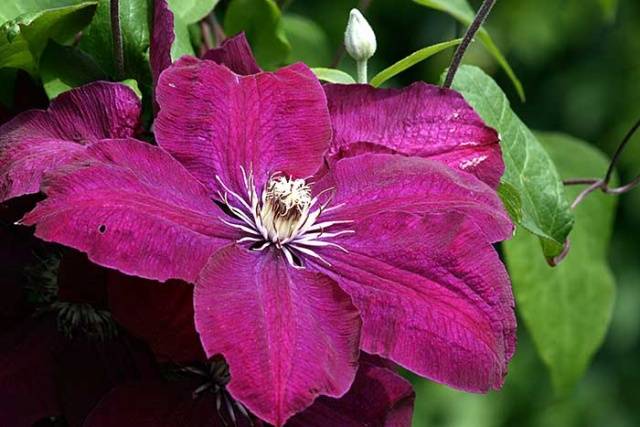
For clematis Rouge Cardinal, pruning for the winter is imperative, and the procedure is performed after flowering. How much it is necessary to shorten the vine depends on its belonging to the group:
- The first group of clematis is not pruned for the winter. The liana stays on a trellis for the winter and hides high in late autumn. Immediately after flowering, damaged and dry shoots are cut off, and the bush is also thinned out with strong thickening. The first group includes clematis with small flowers.
- The second group of clematis is cut in half at the end of flowering. Usually, a part of the vine with a height of about 1,5 m is left above the ground. The second group includes clematis, which bloom in early spring. A large number of flowers appear on trimmed lashes. On new shoots, inflorescences are usually few.
- Clematis of the third group are completely cut in autumn. Above the ground, stems are left with two to three pairs of buds. The height of the protruding shoots should not exceed 20 cm. After pruning, hilling is carried out immediately. Clematis of the third group are distinguished by their abundant color and undemanding care.
For clematis Rouge Cardinal, the third pruning group is suitable. The remaining shoots of the liana, after hilling with earth, are covered with dry foliage. Pine branches are laid on top. If there is a shortage with organic cover, cover the flower with a film or agrofiber.
In the video clematis “Rouge Cardinal” and “Justa”:
Why clematis does not bloom
- Lack of sunlight… This variety loves bright lighting.
- The presence of drafts and constant wind on the site.
- Incorrect feeding: excess or lack of nutrients.
- Soil Moisture.
- The plant is weakened by diseases or pests.
- Incorrect trimming… Clematis blooms on the shoots of the current year, this must be taken into account when pruning in spring.
- Clematis has aged.
Diseases and pests
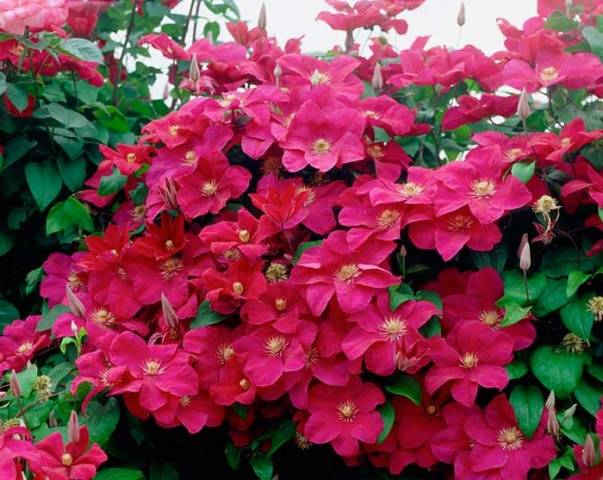
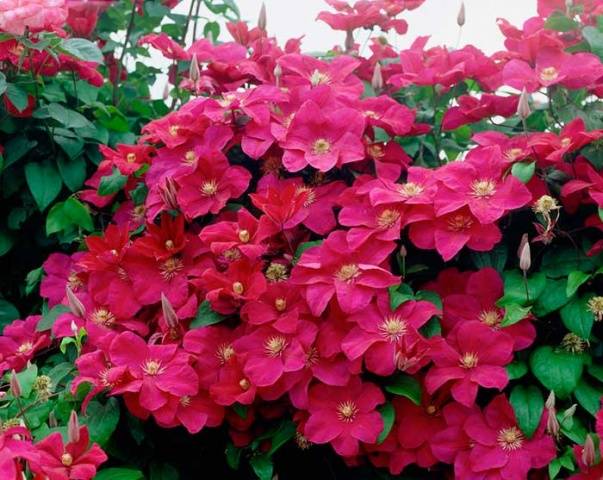
Rouge Cardinal variety is resistant to diseases, but gardeners cannot relax. Preventive treatments for liana are needed from powdery mildew, manifestations of rust, damage by putrefactive bacteria. Wilt poses a great danger to the Rouge Cardinal variety. The affected vine begins to fade and dries quickly. At the first symptoms, the bush should not be spared. Clematis cannot be cured. Liana is dug up and burned.
The best prevention for vines is fungicide treatment. Of the drugs, Quadris and Horus have proven themselves well. Not a bad fungicide Speed. During a drought, the second threat to clematis is the spider mite. To combat the pest, insecticides are used.
Characteristics of the cardinal shotgun
This variety is hybrid and was developed in France by crossing Lanuginoza and Vititsella. Rouge cardinal variety (translated as “red cardinal”) has repeatedly won numerous exhibitions and is rightfully considered one of the best among other varieties of clematis. The flowers of the Cardinal Rouge are large, velvety, with wide petals, of a noble purple color, which is very harmoniously combined with the rich green of the leaves. The climbing shrub grows up to 4 m in height, over the summer it releases up to five shoots.
This variety blooms twice: in June and September. The clematis liana has the ability to independently climb up the support with the help of forked antennae. Due to this property, the shrub can be launched on a support of any shape. In just one summer day, the shoots of this flower can grow 5-10 cm. The shrub is resistant to many parasites and infections, and tolerates winter quite well.
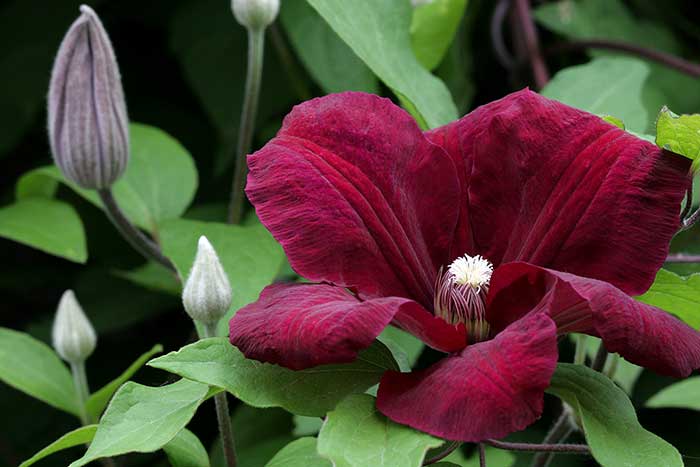
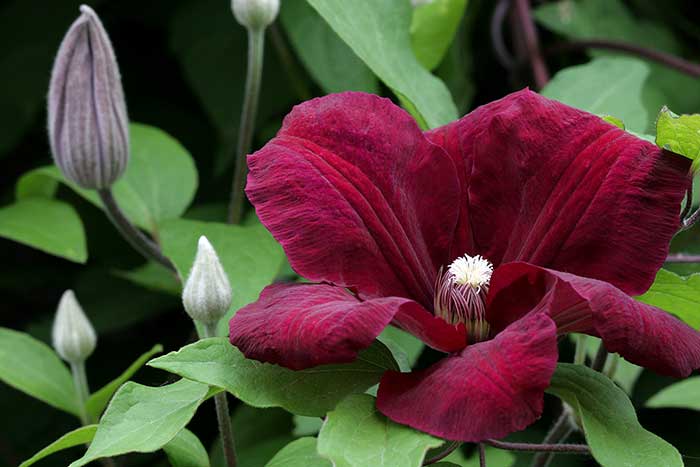
Clematis rouge cardinal blooms in June and September
White clematis varieties
Among the mass of varieties, varieties of white clematis are considered the most beautiful, but also the most capricious.
After all, they require special care, proper pruning and arrangement of support for the growth of vines. White clematis are often combined with pink and blue perennial flowers, which look advantageous next to a snow-white carpet. Most of the white clematis are terry varieties that are more demanding to care for.
Clematis Veronicas Choice
This variety belongs to the large-flowered group and differs from other clematis in its early flowering. The flowers of the plant are double, large, white, 16 cm in diameter, they have a delicate purple hue, which becomes darker towards the middle. The smallest inner flower petals have corrugated edges and a delicate creamy shade. Clematis Veronicas Choice blooms in old shoots twice a year, in June-July and again in August on the youngest twigs. In August, Clematis Veronica Chois no longer gives double flowers, but ordinary flowers, since the bush is weakened and does not have enough nutrients. As Veronica Choyce’s reviews of clematis say, this is a rather tall plant, whose height is no more than 3 meters. It requires support, but if not, then trees, shrubs and other hedges will do. This species is also often used for planting on balconies, where it becomes protection from the scorching sun. Liana easily withstands the frosts of our latitudes, so it does not need additional shelter. This variety was released in 1973 in honor of the daughter of the famous British breeder Walter Pennell.
Clembis Siebold
Propagate by dividing the bush, layering and cuttings
2. Root layers
Process:
- in the fall (in October), make shallow grooves near the bush (up to 10 cm);
- lay side shoots in them, fixing them with metal brackets and covering them with earth (except for the top);
- with the onset of cold weather, cover the bush and shoots with spruce branches or dry leaves;
- water the shoots from spring;
- next fall, separate the rooted shoots from the mother plant and plant in the designated place
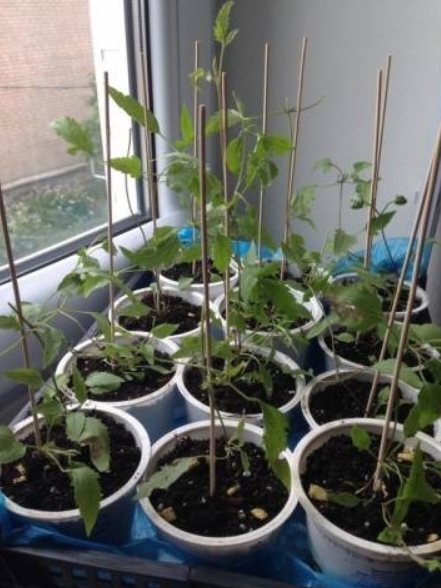
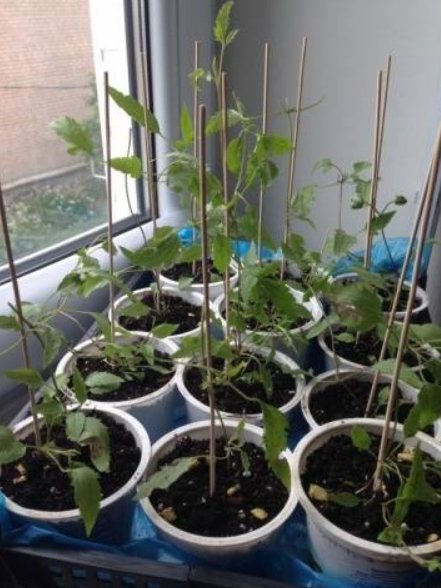
3. Cuttings
Process:
- in spring, summer or autumn, cut green or woody cuttings 8 to 12 cm long;
- keep them in a growth stimulator for a day (epin, root, heteroauxin);
- plant banks in the greenhouse;
- create a humid microclimate and keep the temperature at least 20 degrees, this will allow the cuttings to take root quickly;
- transplant rooted seedlings into open ground
Features of the variety: harmonious tandem of characteristics
Clematis is rightfully considered the king of lianas, because it is not difficult to care for, while it pleases with beautiful flowers of different shapes and shades. It is used for vertical gardening, for ennobling pergolas, gazebos, trellises, walls.
Breeders breed hybrids that delight with different shades of flowers, powerful vegetative mass, and unpretentious care. And among the colorful hybrids, Rouge Cardinal stands out, which was obtained by crossing the varieties Ville de Lyon (1899) and Pourpre Mat (1914). He was bred in 1968 (a hybrid from the Jacquemann group) and received a set of the best qualities from his “parents”.
It differs from others:
- height – 2-4 m, depending on the conditions of care;
- flower shade – red-purple, diameter – 12-16 cm;
- flowering period – summer-first month of autumn;
- exposure – S / V / S / W;
- trimming group – strong, 3rd.
Clematis flower
A striking feature of the variety is the ability to grow in containers, which makes it possible to decorate a loggia / balcony in an apartment. However, the dormant period of such a flower is lengthened.
Attention! Rouge Cardinal variety belongs to winter-hardy varieties, so it does not need shelter. But for safety reasons, small plants (1-3 years old) can be covered with spunbond, covered with buckets from snow drifts and winds.
Care and pruning of handsome clematis: simple rules
Clematis, delighting with beautiful purple flowers and rich green leaves, is a real decoration of the garden. But in order for the plant to be healthy and develop correctly, it is necessary:
- water once every 1 days (in the first years of life), when the flower grows – watering should be increased. In this case, the soil should be wet, but not flooded;
Don’t forget to prune your plant
- feed several times during the growing season. In this case, it is best to combine root dressing and leaf dressing, using organic and complex mineral fertilizers;
- free space from weeds, loosen the soil after rains.
Attention! To create optimal climatic conditions around clematis, you can plant annual flowers or herbs without resorting to mulching. They will protect a small plant from bad weather and winds.
The beauty and power of a bush depends on proper pruning. The Rouge Cardinal variety belongs to the 3rd group, which means that it needs to be cut off every year, leaving the shoulders-sleeves of 20-30 cm / 50 cm, on the young shoots of which flowers will appear the next year. At the same time, on 1 bush, you can form several shoulder-sleeves in a year, pinching the shoot after it grows by 15 cm, then after the growth of the stepsons by 25-30 cm.
Rouge Cardinal will enchant you with its velvety texture, richness of purple and ease of care. It remains only to correctly lay the planting hole and learn how to properly cut the vine (5-7 cm above the bud), guide the pruner. But this is an experience that has been accumulated over the years. It will be easier only for those who grow grapes. And in your garden there will be a true handsome man, charming!
Plant in a sunny area or in partial shade
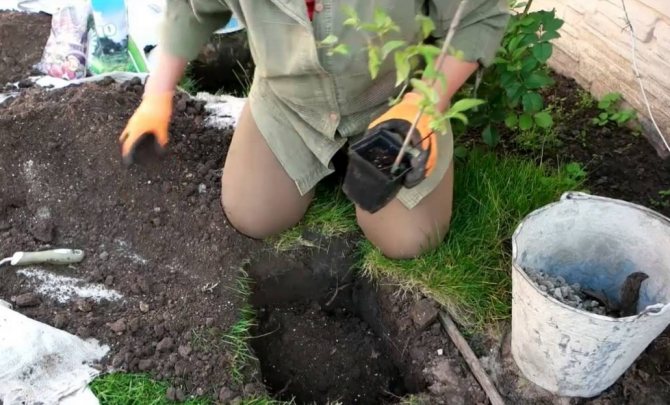
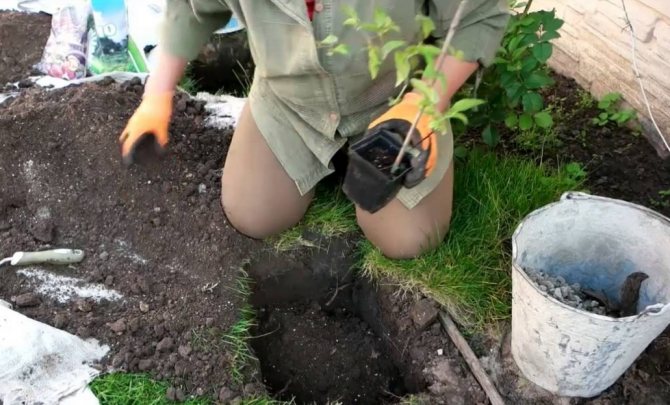
The planting hole should be prepared a month before planting.
- Planting can be done in spring, summer and autumn, but the best time is the first half of autumn.
- Dig a hole 50 – 70 cm wide a month before planting, which will allow the soil to settle and settle. If there are several vines, maintain a distance between the holes of at least 1 – 1.5 m.When planting clematis against a wall, do it at a distance of at least 20 cm.Do not plant the plant near a metal fence, as it gets very hot in the sun and can overheat clematis.
- Lay a drainage layer on the bottom of the pit at 15 – 20 cm. Clematis does not tolerate stagnant water. Care should be taken not to let water run off the roof of the plant when it rains.
- Place a layer of organic fertilizer on top (leaf humus, ash, compost, bulk manure). This will have a beneficial effect on plant development and flowering. If the soil is poor, add superphosphate (50 g per 0.5 mXNUMX), peat and nitrophosphate.
- Pour on top of organic a small layer of fertile soil with a mound.
- Install a support (peg) in the pit.
- Place a plant on a mound of soil mixture, gently straightening the roots.
- Cover the root system with soil so that the root collar is 5 – 8 cm below ground level and lightly tamp the soil.
- Water abundantly.
- Mulch the trunk circle… Clematis does not tolerate overheating of the root system.
Clematis “Kardinal Wyszynski”
The famous Polish variety of clematis, Cardinal Vyshinsky, is a worthy decoration for any garden. Huge flowers with large sepals of bright crimson color contrast with green foliage and allow the gardener to successfully combine them with other plants. Clematis blooms from June to September. The total height of the vine is 2-3 meters.
Cardinal Vyshinsky is used as a climbing plant to decorate the columns of the house, gazebos, fences, special supports: trellises, pyramids, pergolas. This variety is also suitable as a ground cover plant. Perfectly takes root in flower beds and lawns. In addition, it serves as a good element of interior decoration, growing in containers. Diseases and pests

